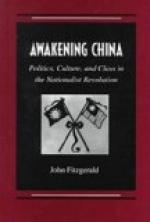Their names are without exception a repetition of those of former dynasties, Liang, T’ang, Ts’in, Han, Chou with the prefix “Later”—suggesting that each claimed to be a lineal successor of some previous imperial family. Their struggles for power, not more instructive than a conflict of gladiators, are so devoid of interest that the half-century covered by them may be passed over as a blank. It may, however, be worth while to remind the reader that as the House of Han was followed by the wars of the “Three Kingdoms,” and that of Ts’in by a struggle of North and South under four states, so the House of T’ang was now [Page 127] succeeded by five short-lived “dynasties,” with a mean duration of scarcely more than ten years. The numerical progression is curious; but it is more important to notice a historical law which native Chinese writers deduce from those scenes of confusion. They state it in this form: “After long union the empire is sure to be divided; after long disruption it is sure to be reunited.”
So deep an impression has this historical generalisation made on the public mind that if the empire were now to be divided between foreign nations, as it has been more than once, the people would confidently expect it to be reintegrated under rulers of their own race.
The undivided Sung dynasty held sway from 960 to 1127; that of the southern Sungs from 1127 to 1280. The founder of the house was Chao-kwang-yun, an able leader of soldiers and an astute politician. So popular was he with his troops that they called him to the throne by acclamation. He was drunk, it is said, when his new dignity was announced, and he had no alternative but to wear the yellow robe that was thrown on his shoulders. Undignified as was his debut, his reign was one continued triumph. After a tenure of seventeen years, he left his successor in possession of nearly the whole of China Proper together with a fatal legacy of lands on the north.
The two main features of the Sung period are the rise of a great school of philosophy and the constant encroachment of the Tartars. The two Chengs being brothers, the names of the five leading philosophers fall into an alliterative line of four syllables, Cheo, [Page 128] Cheng, Chang, Chu. Acute in speculation and patient in research, they succeeded in fixing the interpretation of the sacred books, and in establishing a theory of nature and man from which it is heresy to dissent. The rise of their school marks an intellectual advance as compared with the lettered age of the T’angs. It was an age of daring speculation; but, as constantly happens in China, the authority of these great men was converted into a bondage for posterity. The century in which they flourished (1020-1120) is unique in the history of their country as the age of philosophy. In Europe it was a part of the Dark Ages; and at that time the Western world was convulsed by the Crusades.




